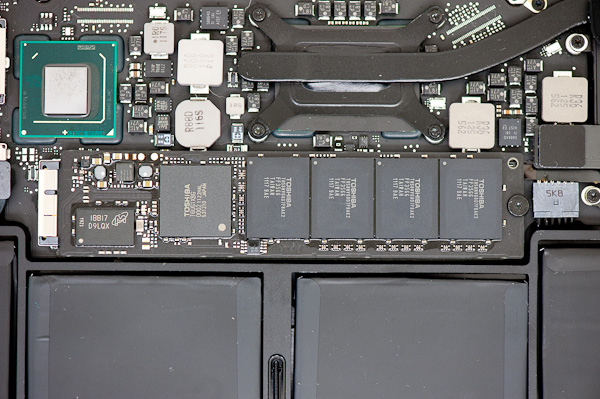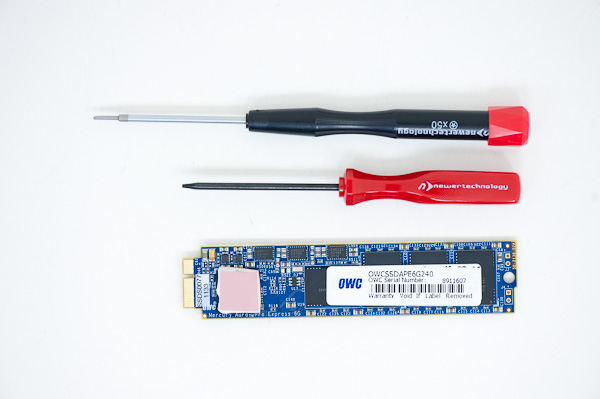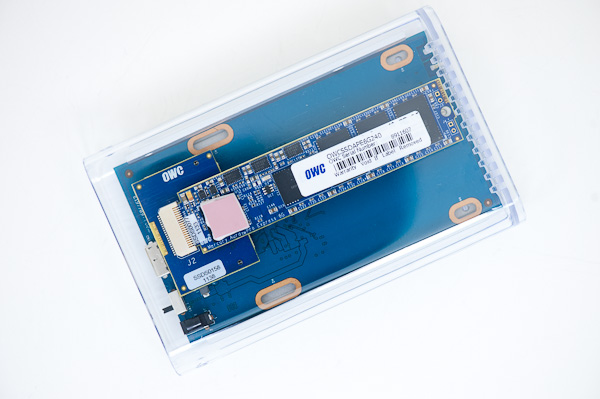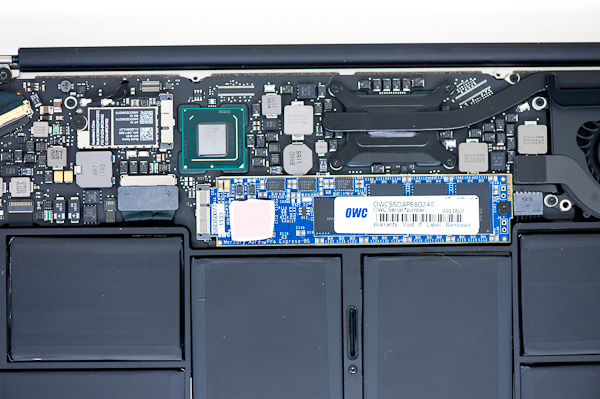OWC Mercury Aura Pro Express 6G Review: A Fast MacBook Air SSD Upgrade
by Anand Lal Shimpi on November 9, 2011 4:18 PM ESTI've written previously about the SSD lottery you play when you buy a new MacBook Air. As with many commodity components, Apple sources its SSDs from two sources. For now, that appears to be Toshiba and Samsung. Apple tends to pick suppliers that can deliver a reliable product in the quantities it's interested in. In the storage space at least, Apple doesn't seem to be overly concerned with performance but rather making sure the solution works.
A year ago, the Toshiba and Samsung controllers offered fairly similar performance. These days the same isn't true. While Samsung has updated its controllers, Toshiba's solution still offers the fairly abysmal random write performance it did a year ago. With the recent release of the Samsung SSD 830, I expect the trend of Samsung drives increasing in performance will continue next year as well.
Unlike the rest of Apple's notebook lineup however, it's not so easy to just swap in a higher performing (or larger capacity) SSD in your MacBook Air. The very first MBAs used a PATA LIF connector, a rarity on most drives. Apple eventually transitioned to a SATA LIF connector, and then with the release of the 2010 MacBook Air we encountered a new thin form factor SSD with a custom interface connector. In all of those cases, the market for third party MacBook Air SSDs popped up at some point post-launch. The 2010/2011 MacBook Air has been no different.
If you've followed the aftermarket Mac support business then OWC should be no stranger to you. If you haven't heard of OWC from their Mac efforts, there's always the fact that second to only OCZ, no one has been quicker at releasing SSDs based on brand new SandForce controllers.
OWC put out an aftermarket drive for owners of 2010 MacBook Airs based on the 3Gbps SF-1200 controller. For 2011 MBA owners there's a 6Gbps SF-2281 option: the OWC Mercury Aura Pro Express 6G.
The drive is available in 120GB and 240GB capacities, for $280 and $550 respectively. Both drives come with pentalobe and torx drivers to aid in opening your MBA and replacing your old drive.
For another $35 OWC will sell you an external USB 2.0/3.0 enclosure that can house your old MBA SSD either to help you transfer your data or give you a sweet, high performance external drive once you're done.
OWC sent me a 240GB Aura Pro, which I installed into an 11-inch MacBook Air. The installation process was a cinch. The only hiccup was that I couldn't just clone my 256GB Toshiba SSD using Disk Utility since the Aura Pro was technically smaller. Instead I used Lion's internet recovery to download and install a fresh copy of OS X, before restoring my data and installing benchmarks.
If you've followed our SSD reviews you'll know what to expect next. SandForce's SF-2281 controller is the fastest option on the market today, while the Toshiba controller Apple uses is pretty much on the opposite end of the spectrum. I ran our standard four-corners Iometer test to put into perspective just how much faster the OWC upgrade is:
| 2011 MacBook Air SSD Performance Comparison | ||||||
| 4KB Random Write (8GB LBA Space, QD3) | 4KB Random Read (QD3) | 128KB Sequential Write | 128KB Sequential Read | |||
| OWC Mercury Aura Pro Express 6G | 88.4 MB/s | 30.4 MB/s | 495.1 MB/s | 451.4 MB/s | ||
| 13-inch MacBook Air (Mid 2011) - Toshiba SSD | 1.65 MB/s | 18.0 MB/s | 204.2 MB/s | 189.5 MB/s | ||
| 11-inch MacBook Air (Mid 2011) - Samsung SSD | 27.2 MB/s | 44.6 MB/s | 258.0 MB/s | 234.4 MB/s | ||
| 11-inch MacBook Air (Late 2010) - Toshiba SSD | 2.49 MB/s | 31.1 MB/s | 147.0 MB/s | 113.0 MB/s | ||
Performance is just staggering. The comparison is borderline unfair because both the Samsung and Toshiba controllers Apple uses in its MacBook Air are really a generation old at this point, while the Mercury Aura Pro Express is the absolute latest and greatest 6Gbps solution SandForce offers. The performance advantage is noticeable. The upgrade does make everything feel snappier, particularly compared to a MBA equipped with a Toshiba SSD. Large file transfers complete quicker and heavy multitasking workloads see an improvement as well.
SandForce achieves this performance advantage by using real time compression and data deduplication algorithms to reduce the amount of data actually written to the NAND. Since much of what we write to our drives in the course of normal use is easily compressible data, SandForce's technology is quite effective. Where the controller falls short however is if you're moving incompressible data, for example already highly compressed videos or encrypted data. While highly compressed content like H.264 movies will really only impact sequential read/write speed, enabling full disk encryption under OS X impacts all of your data. Truly random data is impossible to compress/dedupe, so I enabled FileVault under Lion and re-ran our performance tests on the Aura Pro:
| 2011 MacBook Air SSD Performance Comparison | ||||||
| 4KB Random Write (8GB LBA Space, QD3) | 4KB Random Read (QD3) | 128KB Sequential Write | 128KB Sequential Read | |||
| OWC Mercury Aura Pro Express 6G | 88.4 MB/s | 30.4 MB/s | 495.1 MB/s | 451.4 MB/s | ||
| OWC Mercury Aura Pro Express 6G (Encrypted) | 80.8 MB/s | 28.8 MB/s | 184.8 MB/s | 431.9 MB/s | ||
| Apple Toshiba SSD (Encrypted) | 1.13 MB/s | 19.4 MB/s | 178.7 MB/s | 195.8 MB/s | ||
Sequential write performance takes a pretty significant hit, but the rest of the metrics look ok. In fact, I'd say even if you're running with your drive encrypted you'll have a better experience on the OWC drive than with either of the Apple SSDs.
With the OWC Mercury Aura Pro Express 6G you get much better performance than the stock Apple SSDs regardless of usage. Is there any downside to going with the aftermarket drive? Unfortunately there appears to be one:
| Power Consumption Comparison | ||||
| Idle | Load (Sequential Write) | |||
| OWC Mercury Aura Pro Express 6G | 6.2W | 19.0W | ||
| OWC Mercury Aura Pro Express 6G (Encrypted) | 6.2W | 18.0W | ||
| Apple Toshiba SSD | 5.5W | 16.4W | ||
It's natural for the OWC solution to draw more power under load, you're getting over twice the performance so the increase in power draw is actually not an issue (better power efficiency since you'll be at idle quicker than with a stock SSD). The bigger concern is what happens at idle. My 11-inch MacBook Air typically idles at 5.5W, swapping in the OWC drive increased that idle power consumption to 6.2W. Now this is measured at the wall, so it takes into account AC adapter inefficiency. The actual impact at idle should be somewhere in the 300mW - 400mW range. For a mostly idle workload you'd probably see a 30 minute reduction in battery life.
Final Words
The OWC Mercury Aura Pro Express 6G is a well executed SSD upgrade for 2011 MacBook Air owners. You get an absolutely huge performance increase and an option for users who want the entry level 2011 MBAs but with a larger capacity SSD. If your MacBook Air is your primary workhorse, perhaps even your desktop replacement, and you got stuck with a Toshiba SSD the OWC option makes a lot of sense. OWC thankfully provides everything you need in the box to get into your MacBook Air and swap drives.
The downside is power consumption. At idle the SandForce controller simply draws more power than the Toshiba controller in the MBA we tested. The overall impact on battery life won't be tremendous (perhaps 5% on a mostly idle workload), but if you're already on the edge of usability with the battery life from your stock MacBook Air you may want to remain stock.





















39 Comments
View All Comments
Visual - Thursday, November 10, 2011 - link
Can someone explain to me why random read is slower than random write?Seems to me that there is plenty more complexity and factors that could slow down a write... like if it's not a full block, the drive needs to read the current block so the rest of its content is not lost, erase it or find another already empty one to use, and finally write to it. Then there is waiting for updating the block mapping info, garbage collection and who knows what else...
Is the drive just not waiting for any of those things, instead reporting that the write is done while in fact it has only been written in the DRAM cache? Well, if that is the case then wouldn't a long enough period of such random writes eventually fill up the cache and make the drive have to wait for all the operations anyway? Why does that not happen in the benchmarks?
Or it is something completely different? Would someone please enlighten me?
Visual - Thursday, November 10, 2011 - link
> SandForce achieves this performance advantage by using real time compression and data deduplication algorithms to reduce the amount of data actually written to the NANDAh damn, it was right there in the article... Though it still seems a bit too high of a difference to be because of compression, I'll accept that. I do wonder though, why don't you test with random or already compressed data to show the other side of the rainbow :p
Visual - Thursday, November 10, 2011 - link
And then again, you encrypted data tests still show write much faster than read... back to square one.Also, I promise, this is my last comment without having read the article carefully. Sorry about that.
Donnie Darko - Thursday, November 10, 2011 - link
While I appreciate that the value comment is precarious to make (since some people obviously value things differently) you are talking about a +$500 upgrade to a 1000-1200 laptop.Is it a 50% increase in your user experiance or performance to justtify the 50% increase in product price?
FATCamaro - Thursday, November 10, 2011 - link
What is the OSX version of BSOD?peterfares - Thursday, November 10, 2011 - link
Kernel panicStefanoT - Thursday, November 10, 2011 - link
Now some people will really be tempted to open up their MBAs and toss in this drive, as it has a bigger capacity and higher speed.Squuiid - Thursday, November 10, 2011 - link
TRIM anyone?!robm62 - Thursday, February 23, 2012 - link
I have a late 2010 Air (purchased in 2011/02). I use this machine as a desktop replacement and laptop for Java dev. (but no video)There is nothing wrong with performance. I doubt I would notice a 'faster' SSD 400MB sequential writes!??! While that's fast, any internet fetching would swamp that in no time (think Maven).
What I want eventually is a decent speed, low cost, upgrade from the 64G that came with the machine (and is only half used up) but that does NOT degrade battery life. How about $99 128G, 5Watts at idle and 15W under load.
That would be better all around product. Why pay for gee whiz performance I won't utilize at the cost of battery life?